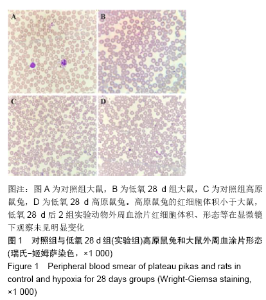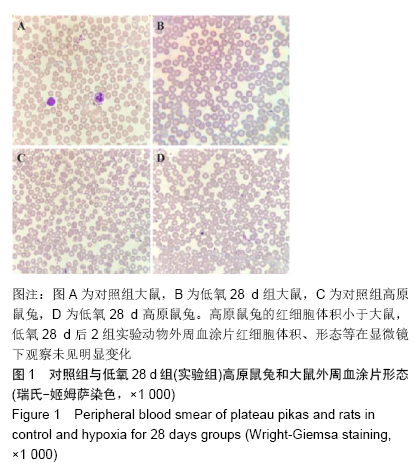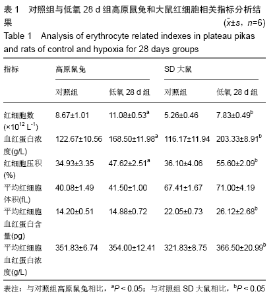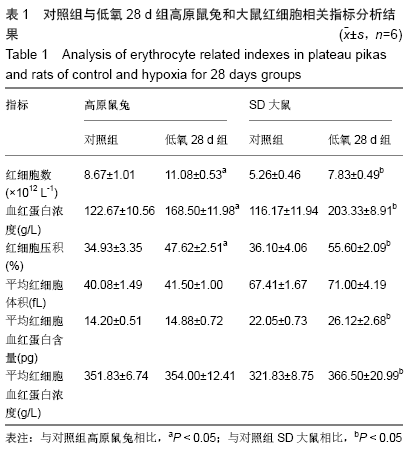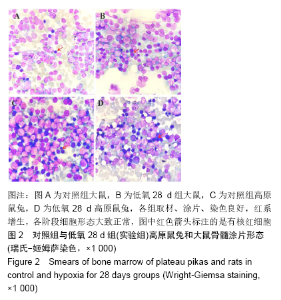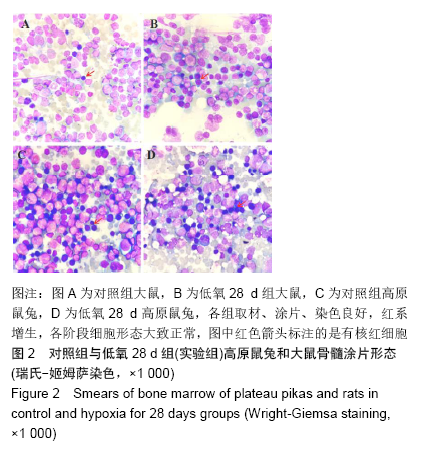[1] XIE HC, HE JP, ZHU JF, et al. Expression of HIF-1alpha and VEGF in skeletal muscle of plateau animals in response to hypoxic stress. Physiol Res. 2014;63(6):801-805.
[2] CAO XF, BAI ZZ, MA L, et al. Metabolic Alterations of Qinghai-Tibet Plateau Pikas in Adaptation to High Altitude. High Alt Med Biol. 2017; 18(3):219-225.
[3] PICHON A, VOITURON N, BAI Z, et al. Comparative ventilatory strategies of acclimated rats and burrowing plateau pika (Ochotona curzoniae) in response to hypoxic-hypercapnia. Comp Biochem Physiol A Mol Integr Physiol. 2015;187:103-110.
[4] 阮宗海,陈华伟,陈秋红,等.不同海拔高原鼠兔、大白鼠血红蛋白电泳及血液学对比观察[J].中国应用生理学杂志,2000,16(1): 92-96.
[5] YINGZHONG Y, YUE C, GUOEN J, et al. Molecular cloning and characterization of hemoglobin alpha and beta chains from plateau pika (Ochotona curzoniae) living at high altitude. Gene. 2007;403(1-2): 118-124.
[6] 王福宁,唐美霞,陈志,等.不同海拔高原鼠兔的血象指标测定[J].青海畜牧兽医杂志,2015,45(2):15-16.
[7] GONZÁLEZ-MORALES JC, BEAMONTE-BARRIENTOS R, BASTIAANS E, et al. A Mountain or a Plateau? Hematological Traits Vary Nonlinearly with Altitude in a Highland Lizard. Physiol Biochem Zool. 2017;90(6):638-645.
[8] VILLAFUERTE FC, CORANTE N. Chronic mountain sickness: clinical aspects, etiology, management, and treatment. High Alt Med Biol. 2016;17(2):61-69.
[9] SIMONSON TS, YANG Y, HUFF CD, et al. Genetic evidence for high-altitude adaptation in Tibet. Science. 2010;329(5987):72-75.
[10] CRAWFORD JE, AMARU R, SONG J, et al. Natural selection on genes related to cardiovascular health in high-altitude adapted andeans. Am J Hum Genet. 2017;101(5):752-767.
[11] 李梦真.青藏高原动物对环境的适应机制研究进展[J].青海科技, 2017, 24(3):56-59.
[12] BARVE S, DHONDT AA, MATHUR VB, et al. Life-history characteristics influence physiological strategies to cope with hypoxia in Himalayan birds. Proc Biol Sci. 2016;283(1843):20162201.
[13] ESTEVA S, PANISELLO P, TORRELLA JR, et al. Blood rheology adjustments in rats after a program of intermittent exposure to hypobaric hypoxia. High Alt Med Biol. 2009;10(3):275-281.
[14] BALABAN DY, DUFFIN J, PREISS D, et al. The in-vivo oxyhaemoglobin dissociation curve at sea level and high altitude. Respir Physiol Neurobiol. 2013;186(1):45-52.
[15] 马兰,格日力.高原鼠兔低氧适应分子机制的研究进展[J].生理科学进展, 2007,38(2):143-146.
[16] LI W, WANG Y, ZHAO H, et al. Identification and transcriptome analysis of erythroblastic island macrophages. Blood. 2019;134(5):480-491.
[17] LUNDBY C, PILEGAARD H, ANDERSEN JL, et al. Acclimatization to 4100 m does not change capillary density or mRNA expression of potential angiogenesis regulatory factors in human skeletal muscle. J Exp Biol. 2004;207(Pt 22):3865-3871.
[18] JELKMANN W. Erythropoietin. Front Horm Res. 2016;47:115-127.
[19] 王丽平,余群,翁锡全,等.运动性低血红蛋白模型大鼠间歇低氧暴露后红细胞、网织红细胞参数及促红细胞生成素含量变化[J].中国组织工程研究, 2018,22(20):3207-3212.
[20] 张涵,胡正霞,兰海.微创全髋关节围置换期应用重组人促红细胞生成素联合氨甲环酸[J].中国组织工程研究,2018,22(7):1003-1008.
[21] SU J, LI Z, CUI S, et al. The local HIF-2α/EPO pathway in the bone marrow is associated with excessive erythrocytosis and the increase in bone marrow microvessel density in chronic mountain sickness. High Alt Med Biol. 2015;16(4):318-330.
[22] ALVAREZ-MARTINS I, REMÉDIO L, MATIAS I, et al. The impact of chronic intermittent hypoxia on hematopoiesis and the bone marrow microenvironment. Pflugers Arch. 2016;468(5):919-932.
[23] HAYASHIDA K, FUJITA J, MIYAKE Y, et al. Bone marrow-derived cells contribute to pulmonary vascular remodeling in hypoxia-induced pulmonary hypertension. Chest. 2005;127(5):1793-1798.
[24] LEMUS-VARELA ML, FLORES-SOTO ME, CERVANTES-MUNGUÍA R, et al. Expression of HIF-1 alpha, VEGF and EPO in peripheral blood from patients with two cardiac abnormalities associated with hypoxia. Clin Biochem. 2010;43(3):234-239.
[25] XIE HC, LI JG, HE JP. Differential responsiveness in VEGF receptor subtypes to hypoxic stress in various tissues of plateau animals. Physiol Res. 2017;66(2):357-362.
|
